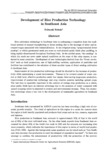Development of Rice Production Technology in Southeast Asia
JIRCAS international symposium series
| ISSN | 13406108 |
|---|---|
| 書誌レコードID(総合目録DB) | AA1100908X |

本文フルテキスト
intlsymp-6_145-154.pdf303.97 KB
Rice cultivation technology in Southeast Asia is undergoing a transition from the traditional method of manual transplanting to direct seeding due to the shortage of labor and increased wages associated with industrialization. In the irrigated areas, "pregerminated direct seeding", in which germinated seeds are sown on well-drained paddy fields after puddling, is being rapidly disseminated throughout Southeast Asia. In the rainfed areas, "dry seeding", in which dry seeds are sown under upland conditions at the onset of the rainy season, is conducted in some countries. Development of new technologies derived from the "Green revolution" such as land preparation, use of high-yielding varieties, application of pesticides and fertilizer has contributed to the adoption of these peculiar types of direct seeding cultivation in Southeast Asia.
Improvement of rice production technology should be directed to the increase of productivity while maintaining a sound environment. Themes to be covered consist of water control at field level, effective production under low inputs, labor-saving large-scale production, improvement of postharvest technology and crop rotation systems including upland crops. The last item is especially important in the context of raising crop production as a whole, since paddy fields have an inherent advantage due to the presence of water compared with upland cropping which is subjected to erosion and environmental stresses. Thus, rice production technology plays a key role in the development of sustainable agriculture in Southeast Asia.
Improvement of rice production technology should be directed to the increase of productivity while maintaining a sound environment. Themes to be covered consist of water control at field level, effective production under low inputs, labor-saving large-scale production, improvement of postharvest technology and crop rotation systems including upland crops. The last item is especially important in the context of raising crop production as a whole, since paddy fields have an inherent advantage due to the presence of water compared with upland cropping which is subjected to erosion and environmental stresses. Thus, rice production technology plays a key role in the development of sustainable agriculture in Southeast Asia.
| 作成者 | Nobuyuki Kabaki |
|---|---|
| 公開者 | Japan International Research Center for Agricultural Sciences |
| オンライン掲載日 | |
| 号 | 6 |
| 開始ページ | 145 |
| 終了ページ | 154 |
| 言語 | eng |
